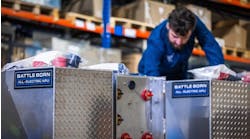The Trucking Injury Reduction Emphasis project, or TIRES, is rolling out a new tool to help keep truckers safe and on the road – the TIRES blog. TIRES is an injury prevention project developed by the Safety and Health Assessment and Research for Prevention (SHARP) program, the research unit for the Washington Dept. of Labor & Industries (L&I).
SHARP research shows that trucking has some of the highest injury claims and workers' compensation rates in the state of Washington. TIRES’ goal is to decrease the number of work-related injuries in trucking by targeting the most common injury types for prevention activities.
“The goal of the TIRES project is to cut down on the injuries truckers suffer and the costs to employers associated with these injuries,” said Caroline Smith, TIRES project manager. “We want to use this blog to help further this important work by sharing information on trucking safety and providing a platform where those in the trucking industry can share stories about trucking hazards and ways they’ve learned to minimize the risks.”
The most common types of injuries in the trucking industry identified by TIRES include:
• Slips, trips and falls.
• Strains and sprains.
• Being struck by an object.
• Motor vehicle collisions.
From this data TIRES learned that the root causes of most of these injuries was attributable to four specific work activitites in trucking:
• Loading/unloading and material handling.
• Exiting the cab or trailer.
• Walking around the yard, terminal or customer site.
• Tarping/strapping a load.
The TIRES research team is working with industry leaders, safety and health professionals, employers, drivers, warehouse and dock workers, and many others to develop educational materials that identify hazards and provide low-cost, simple solutions to prevent injuries in the trucking industry.
The team at TIRES produces posters, videos, and hosts a website, www.KeepTruckingSafe.org, with several trucking industry partners to address these injuries. The new blog is available there and at Tires.lni.wa.gov.
The group plans to visit worksites to identify best practices and pilot test new ideas aimed at reducing the target injuries. The work is paid for by a grant from the CDC/NIOSH and the Washington State Dept. of Labor & Industries.


